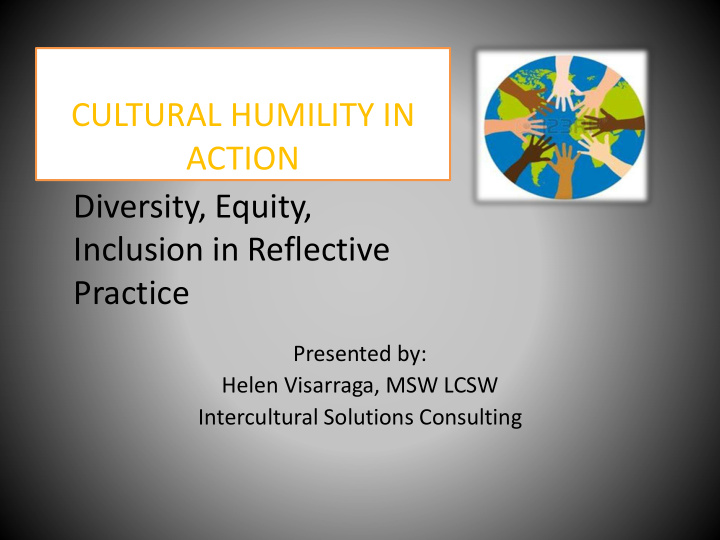



CULTURAL HUMILITY IN ACTION Diversity, Equity, Inclusion in Reflective Practice Presented by: Helen Visarraga, MSW LCSW Intercultural Solutions Consulting
TRAINING OBJECTIVES ✓ Understand and integrate DEI concepts into individual reflective practice, reflective supervision and conversations within the workplace. ✓ Understand and examine equity and race as elements of conscious reflective practice. ✓ Demonstrate cultural humility in thoughts, words, feelings and actions through on-going self-reflection. ✓ Use of: Honest Compassionate Communication & Nonverbal Communication in supervision session
DEI DEFINITIONS – BUILDING A COMMON LANGUAGE
DEI Definitions Cont.
WHAT IS EQUITY?
WHAT IS EQUALITY?
WHAT IS CULTURAL HUMILITY? UNDERSTANDING CONNECTION SELF REFLECTION EVERYBODY IS ROOTED IN CULTURE
UNDERSTANDING A gradual movement in developing awareness as to how the DEI principles apply to oneself
CONNECTION • A conscious connection and awareness of how images or (memories) from our past lived experiences help or deter our present rate of future growth and development.
SELF-REFLECTION The ability to develop the understanding that what we may be seeing in others exists first within ourselves (positive, negative, or indifferent). Our Subjective World
CULTURE IS ALL-INCLUSIVE • Infant mental health, or healthy social-emotional development in very young children, develops in the context of family, community, and cultural expectations. – Parent child relationships – Family parenting styles/beliefs – Language, ethnicity, religion or spirituality – Financial security/Literacy level – External community systems/services – Socio economic dynamics
EVERYBODY IS ROOTED IN CULTURE BELIEFS LANGUAGE BIASES NORMS PREFERENCES VALUES GENDER IDENTITY BEHAVIORS ALL LIVED EXPERIENCES SELF-CONCEPT RELIGION/SPIRITUALITY CONCEPT OF OTHERS POLITICS COMMUNICATION STYLE HEALTH/HEALING PRACTICES LANGUAGE EDUCATION
INDIVIDUAL DIFFERENCES • Avoid “cookie cutter” approach • Within each ethnic/cultural group – great differences exist • Look at, listen to, and learn from each individual family/parent/caregiver and child
LANGUAGE SENSITIVITY • Bi-lingual staff and/or parents/caregivers may not fully comprehend based on level of language literacy. (Speaking a language does not necessarily translate into cognition.) • Usually literacy is more advanced in the language of choice, as the second or third language is developing. • Check in often to receive feedback during the conversation to ensure understanding.
SHARE BITS OF YOUR OWN ETHNIC/CULTURAL EXPERIENCES Examples: -family parenting styles, beliefs (some meaningful anecdote from your own cultural lived experiences) -a particular way of celebrating birthdays, special rites of passage, or special or memorable occasions that stands out. WHAT ELSE?
CULTURAL JOURNEY • Each participant selects one of two of the cultural elements and shares with a partner. • Engaging in learning about your own cultural journey helps develop sensitivity to the diverse cultural/ethnic patterns and behaviors of others
SOME TYPICAL COMMUNICATION STYLES • Power differential (assumptions/tendencies) • Extrovert/introvert • Assertive/passive • Individualism/Collectivism (I learn better individually or with others) • Open, closed, rigid, fluid • Commanding, expecting, directing vs. allowing, exploring, examining, and understanding
NON-VERBALS GOVERN WHAT WE THINK AND HOW WE FEEL ABOUT OURSELVES • https://www.ted.com/talks/amy_cuddy_your_ body_language_shapes_who_you_are#t- 423814
INCLUSION SELF-REFLECTION
INDIVIDUAL/GROUP ACTIVITY Form a dyad: A. Speaker B. Listener Speaker (A) relates the Anna’s story based on his/her interpretation. Listener (B) listens attentively using non verbal cues only to acknowledge what the speaker is trying to communicate. Listener (B) then uses both verbal and nonverbal communication to relate to speaker what she/he/they understood about Anna’s story.
HOW WE FORM BELIEFS
DEVELOPING AN IDEAL STEP ONE: What is your goal/intention/ideal for yourself based on today’s discussion? STEP TWO: What steps are you willing to put into action on a daily basis to develop your ideal? STEP THREE: How will you monitor your own progress for developing your ideal?
INCLUSION
Recommend
More recommend